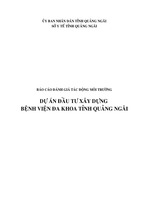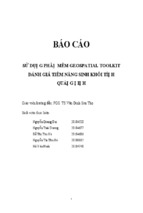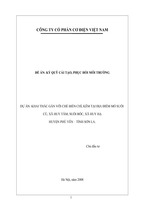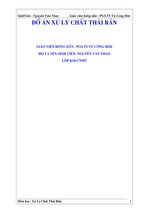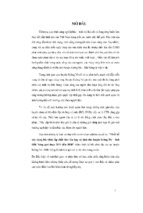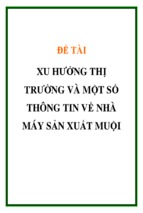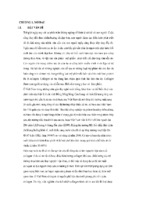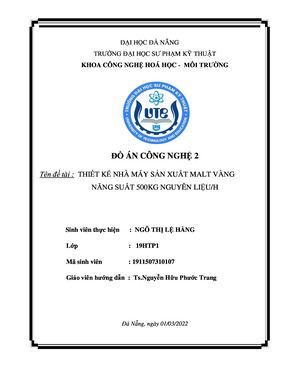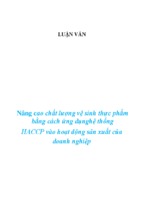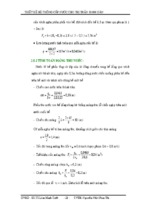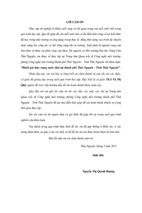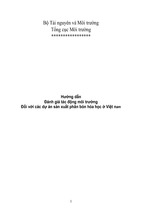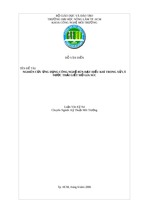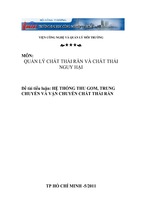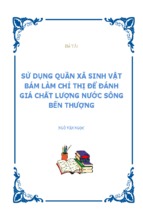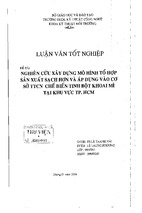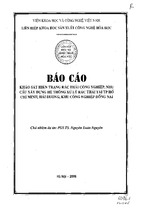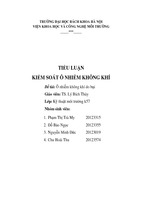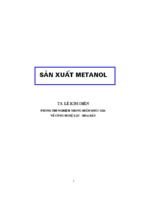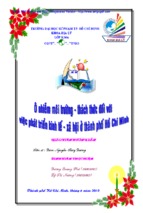THAI NGUYEN UNIVERSITY
UNIVERSITY OF AGRICULTURAL AND FORESTRY
TRAN THI LAN HUONG
TOPIC TITLE: ASSESSMENT ON SITUATION OF WASTEWATER
OF DA RIVER LEFT-BANK INDUSTRIAL ZONE, HOA BINH CITY
IN THE 2013 – 2014 PERIODS
BACHELOR THESIS
Study Mode: Full-time
Major: Environmental Sciences and Management
Faculty: International Training and Development Center
Batch: 2010 - 2015
Thai Nguyen, 17/01/2015
i
Thai Nguyen University of Agriculture and Forestry
Degree Program
Bachelor of Environmental Science and Management
Student name
Tran Thi Lan Huong
Student ID
DTN 1053180056
Thesis title
Assessment of wastewater of Da River Left-bank
Industrial Zone - Hoa Binh City on the 2013-2014 period
Supervisor(s)
Assoc. Prof. Dr. Do Thi Lan
MA. Truong Thi Anh Tuyet
Abstract:
The purpose of this study is to assess wastewater of Da River Left-bank
Industrial Zone- Hoa Binh City in the 2013-2014 periods.
The main focus is in two aspects: to assess the status of wastewater treatment of
Da River Left-bank Industrial Zone and to propose solutions for decreasing the water
pollution. Regarding to the state of wastewater treatment, Da River Left-bank
Industrial Zone is a place that has largest amount of wastewater discharge in Hoa Binh
City. In the Industrial Zone, a number of companies discharged wastewater directly
into Dung stream (flowing to Da River) an extremely large amount of domestic and
industrial wastewater, that seriously exceed the permissible standards. Besides, many
companies had administrative violations in the discharge of wastewater or did not have
enough legal documents following regulation in wastewater management.
Currently, Da River Left-bank Industrial Zone starts to build the wastewater
treatment system in order to have effective wastewater treatment and simple discharge
management. After assessing the situation in the Industrial Zone, the essential
solutions are proposed. In term of management, local authorities need to take coercive
measures against companies which discharged the untreated or unsatisfactory treated
wastewater directly into environment. With technological solution, the Industrial Zone
has to select appropriate production technologies, innovative technology of wastewater
treatment system.
Overall, the options considered and evaluated in the thesis indicated that Da
River Left-bank Industrial Zone can implement those options to prevent and manage
the quality of wastewater in order to protect environment in a legal, logical and
financially practical way.
Keywords
Number of pages:
Date of submission:
Industrial Zone, wastewater, treatment, pollution,
discharge, industry, domestic, etc.
58
January 15, 2015
ii
ACKNOWLEDGEMENT
I would like to express my gratitude to my supervisors, Assoc. Prof. Dr. Do Thi Lan
and MA. Truong Thi Anh Tuyet for their invaluable useful comments, remarks,
encouragement and engagement through the learning process of this graduated
thesis.
I sincerely thank the lecturers who enthusiastically imparted useful
knowledge on water treatment during the University program to all class attendants.
I also thank the support of Thai Nguyen University of Agriculture and Forestry, the
coordinators and program managers for their support and assistance.
I am using this opportunity to express my gratitude to my classmates, who
supported me throughout this course, by their aspiring guidance, invaluably
constructive criticism and friendly advice. I am sincerely grateful to them for
sharing their truthful and illuminating views on a number of issues related to my
thesis.
Also, I like to thank the participants in my survey, who have willingly shared their
precious time during the process of interviewing. I would like to thank my loved
ones, who have supported me throughout entire process, both by keeping me
harmonious and helping me putting pieces together.
Thank you all very much!
Sincerely yours,
iii
TABLE OF CONTENT
List of Tables........................................................................................................... 1
List of Figures ......................................................................................................... 2
List of Abbreviations .............................................................................................. 3
PART I. INTRODUCTION................................................................................... 4
1.1. Rationale ...................................................................................................... 4
1.2. Definitions ................................................................................................... 5
1.3. Aims of the study ......................................................................................... 5
1.4. Research questions ..................................................................................... 5
1.5. Research significance ................................................................................. 5
1.5.1. Practical significance .............................................................................. 6
1.5.2. Learning and scientific research significance .......................................... 6
1.6. Limitations .................................................................................................. 6
PART 2. LITERATURE REVIEW ..................................................................... 8
2.1. Theoretical background .............................................................................. 8
2.2. Scientific background .................................................................................. 9
2.2.1. Related definitions ................................................................................... 9
2.2.2. Water quality assessment ......................................................................... 10
2.3. Empirical background ................................................................................ 14
2.3.1. Water resources and situation of water pollution in the world ............... 14
2.3.2. Studies on water quality in Vietnam ......................................................... 15
2.4. Study area review ........................................................................................ 18
2.4.1. Natural and socio-economic conditions of Hoa Binh City ....................... 18
2.4.1.1. Natural conditions ................................................................................ 18
iv
2.4.1.2. Socio-economic conditions .................................................................. 21
2.5. General assessment of review ...................................................................... 25
PART III. METHODS ........................................................................................... 26
3.1. Object and scope of study ............................................................................ 26
3.2. Location and time of study ......................................................................... 26
3.3. Research content .......................................................................................... 26
3.3.1. Basic characteristics of Da River Left-bank Industrial Zone – Hoa Binh
City ........................................................................................................................... 26
3.3.2. Assessment of current status of water quality of the industry .................. 26
3.3.3. Proposal of a number of solutions to reduce pollution and effects
of wastewater to surrounding environment ............................................................ 26
3.4. Research methods ........................................................................................ 27
3.4.1. Secondary data collection method ........................................................... 27
3.4.2. Methods of getting, maintaining and analyzing samples ......................... 27
3.4.3. Question and Interview methods ............................................................... 29
3.4.4. Analyzing, synthesizing and assessing data methods ................................ 29
PART IV. RESULTS ............................................................................................. 30
4.1. Overview of Da River Left-bank Industrial Zone .................................... 30
4.1.1. Status of operation and implementation of environmental protection of
some companies in Da River Left-bank Industrial Zone ......................................... 30
4.1.2. The situation of wastewater treatment of Da River Left-bank Industrial
Zone ......................................................................................................................... 38
4.2. Assessment of current situation of water in Da River Left-bank
Industrial Zone and surrounding areas .............................................................. 40
4.2.1. Current situation of Da River Left-bank Industrial Zone’s wastewater .. 41
4.2.1.1. Situation of wastewater of Da River Left-bank Industrial Zone in 2013
.................................................................................................................................. 41
v
4.2.1.2. Situation of wastewater of Da River Left-bank Industrial Zone in 2014
.................................................................................................................................. 43
4.2.2. Assessment of wastewater’s impacts of Da River Left-bank Industrial Zone
to local people based on survey............................................................................... 48
4.2.2.1. Basic information of investigated subject .......................................... 49
4.2.2.2. Assessment of wastewater’s impacts of the Industrial Zone to local
people........................................................................................................................ 49
4.3. Recommendation of solutions to overcome and minimize water pollution
of Da River Let-bank Industrial Zone ................................................................. 54
4.3.1. Management solutions ............................................................................. 54
4.3.2. Technological solutions............................................................................ 55
PART V. DISCUSSION AND CONCLUSION .................................................. 60
5.1. Discussion ..................................................................................................... 60
5.2. Conclusion .................................................................................................... 61
REFERENCES ....................................................................................................... 62
APPENDICES......................................................................................................... 65
vi
LIST OF FIGURES
Figure 1: Diagram of wastewater treatment technology of Left Side Da River
Industrial Zone................................................................................................... ...............39
Figure 2: Concentration of BOD5, COD and TSS in 2013, 2014 in wastewater at
discharged point into environment of wastewater treatment plant - Huu Nghi JSC
for Agricultural and Forestry Products............................................................ .................44
Figure 3: The concentration of Absorbable Organic Halogens, 2013 and 2014 in
wastewater sample at the discharged point into environment of wastewater
treatment system , Huu Nghi JSC for Agricultural and Forestry Products ... ...................45
Figure 4: The concentration of BOD5 in 2013 and 2014 in the domestic wastewater
sample at the discharged point into environment, R technical research Vietnam Co,
Ltd............................................................................................................................. ........47
Figure 5: The concentration of Total Coliform in 2013 and 2014 in domestic
wastewater at the discharged point into environment, R technical research Vietnam
Co, Ltd ...................................................................................................................... ........48
Figure 6: The proportion of men and women of investigated groups ...................... ........49
Figure 7: The proportion of careers of investigated groups .................................... ........49
Figure 8: Diagram of wastewater treatment technology .......................................... ........57
1
LIST OF TABLES
Table 1: Distribution of land use in Hoa Binh City in 2014 ................................ ............24
Table 2. Fuel and water consumption of some operating companies in Left Side Da
River Industrial Zone.............................................................................................. ..........31
Table 3: Result of analysis of wastewater samples at discharge point into the
environment - Huu Nghi JSC for Agricultural and Forestry Products................. ............41
Table 4: Result of analysis of domestic wastewater sample at discharge point - R
technical research Vietnam Co, Ltd in 2013 ..................................................... ...............42
Table 5: The result of analysis of industrial wastewater at discharge point into
environment - Huu Nghi JSC for Agricultural and Forestry Products................... ..........43
Table 6: The result of analysis of domestic wastewater sample at the discharged
point - R technical research Vietnam Co, Ltd in 2014 ......................................... ............46
Table 7: The impact of wastewater of the Industrial Zone to agriculture production
and the health of people living around there ........................................................ ............51
2
LIST OF ABBREVIATIONS AND ACRONYMS
AOX
: Absorbable Organic Halogens
BOD
: Biochemical Oxygen Demand
COD
: Chemical Oxygen Demand
EPA
: Environmental Protection Agency
DNRE
: Department of Natural Resources and Environment
JSC
: Joint Stock Company
LEP
: Law on Environmental Protection
MNRE
: Ministry of Natural Resource and Environment
TSS
: Total Suspended Solids
VEA
: Vietnam Environment Administration
3
PART I
INTRODUCTION
1.1. Rationale
Environment is a system of natural and artificial material factors which impact on the
survival and the development of humans and animals (Environmental Protection Act,
2014). Those factors are considered as basic components of the environment; they
formed and developed under the law of nature.
One of the most crucial and necessary factors for all life on earth in general and human
in particular is water. It does not only affect human’s health, dietary needs, daily
activities, but it is also a factor to ensure the prosperity of mankind. Nowadays, the
development of science and technology has accelerated the pace of socio-economic
development, creating a giant volume of material goods for meeting the growing
demands of human. However, the socio-economic development, especially the rapid
development of the industry in recent years has discharged a huge amount of
wastewater. This is the direct cause of the environmental pollution in general and
water quality decline in particular, that makes clean water on Earth become
increasingly scarce and exhausted.
As a country with a growing economy, Vietnam has become the heavily polluted water
on the world. Among them, the Da River Left-bank Industrial Zone which located on
Huu Nghi Ward, Hoa Binh City is one of the hot spots of wastewater pollutants,
especially industrial wastewater.
The Industrial Zone is consisted of many companies operating in different fields such
as productions of plastic sheet, insulator, plastic tube with hydrocarbon polymer,
4
silicone rubber; spare parts for cars and motorcycles; automobile engine, sanitary ware
products; hardware assessories, barcode printers, beer, sugar, etc.
Due to the versatility of the Industrial Zone, wastewater is harmful and impacts on the
environment not only the Industry Zone but also surrounding area.
Derived from the reality, through the agreement of Dean of Environmental Faculty
and International Training and Development Center - Thai Nguyen University of
Agriculture and Forestry, the study researched on subject: “Assessment of wastewater
of Da River Left-bank Industrial Zone on the 2013 – 2014 periods”.
1.2. Definitions
This study assesses the status of wastewater of Da River Left-bank Industrial Zone on
the 2013 – 2014 periods in order to determine the impact of wastewater to the
environment. Thus, a number of solutions are proposed to mitigate the effects of
wastewater to the environment surrounding the Industrial Zone.
1.3. Aims of the study
- Learn the basic characteristics of Da River Left-bank Industrial Zone
- Learn and assess the situation of water quality of the Industrial Zone.
- Propose solutions to reduce water pollution of the Industrial Zone.
1.4. Research questions
- What is an overview of Da River Left-bank Industrial Zone?
- What is current situation of water of the Industrial Zone?
- What can human do to reduce water pollution of the Industrial Zone and its impacts
to human and environment?
1.5. Research significance
1.5.1. Practical significance
5
Through the study of wastewater situation of the Industrial Zone, it is significant to
know strengths, weaknesses, challenges and shortcomings in the wastewater
management and treatment in order to find the solutions for environmental protection
in accordance with the conditions of the Industrial Zone, allowing better
environmental management.
1.5.2. Learning and scientific research significance
- Help students apply theory into reality, practice the data synthesis and analysis skills.
- To be a favorable condition for acquiring and learning from practical experience. At
the same time, enhance practical knowledge; add more materials for learning and
researching after graduation.
- Strengthen based knowledge and specialized knowledge to serve environmental
work.
- The success of this study is a basis to improve working methods scientifically and to
help students synthesizing and arranging the schedule and timeline reasonable.
1.6. Limitations
- Due to limitation of time and resources, this study mainly focuses on the water
pollution in Da River Left-bank Industrial Zone.
- The survey is examined is relatively small, the findings cannot be generalized to the
broader community.
- The wastewater data is only taken from 02 companies in the Industrial Zone, it would
not achieve absolute accuracy for the Industrial Zone.
- The measurement and sampling time is only done 2 times/ year. So, the samples
cannot reflect the entire of pollution.
6
- This study solely mentions to the wastewater of the Industrial Zone in short term of
the 2013-2014 periods.
7
PART II
LITERATURE REVIEW
2.1. Theoretical background
- Vietnam’s Strategic Environmental Protection Plan towards 2010 and orientation to
2020,
- Environmental Protection Law No. 55/2014/ QH13 passed by the 13th National
Assembly on June 23, 2014.
- Water Resources Act, June 2012
- Decree No. 120/2008 / ND - CP of the Government dated on December 01, 2008 on
the management of river basins.
- Decree No. 149/2004 / ND - CP of the Government dated on July 27, 2004 on
issuance of permits for water resource exploration, exploitation and use, and discharge
of wastewater into water source.
- Decision No. 16/2008 / QD – BTNMT dated on December 31, 2008 by the Ministry
of Natural Resources and Environment on the National technical regulations on
environment.
- Decision No 104/2000 / QD - TTg dated on August 25, 2000 of the Prime Minister
on approving the national strategy on water supply and rural sanitation towards 2020.
- National technical regulation QCVN 08:2008/BTNMT on surface water quality
- National technical regulation QCVN14:2008/BTNMT on domestic wastewater
quality
8
- National technical regulation QCVN 12:2008/BTNMT on the effluent of pulp and
paper mills
- National technical regulation QCVN 40:2011/BTNMT on industrial wastewater
quality
2.2. Scientific background
2.2.1. Related definitions
- Environment
According to term 1- article 3 of the Law on environmental protection (The National
Assembly of Vietnam, 2014), environment is defined as “a system of natural and
artificial physical factors affecting the existence and development of human beings
and creatures”.
- Environmental pollution
According to term 8 – article 3 of the Law on environmental protection (The National
Assembly of Vietnam, 2014), Environmental pollution refers to “the change in the
environment components in breach of technical regulations on environment and
environmental standards, which can result in adverse impacts on human beings and
creatures”.
- Water resources
According to Jason A. Hubbart and Jacqueline (2013), “Water resources are used in
various ways including direct consumption, agricultural irrigation, fisheries,
hydropower, industrial production, recreation, navigation, environmental protection,
9
the disposal and treatment of sewage, and industrial effluents. Water has sources and
supplies, economic, social, and political characteristics which make it a unique and
challenging natural resource to manage.”
- Water pollution
“Water pollution is a worse change of physical, chemical, and biological properties in
water, with the presence of abnormal substances in liquid and solid form, making
water become toxic to humans and organisms, and reducing biodiversity in water. In
terms of speed and scale of impact, water pollution needs to be concerned more than
soil contamination” (Le Van Thien, 2007).
- Environmental standards
Environmental standards are referred in term 6 – Article 3 of the Law on
Environmental protection (The National Assembly of Vietnam, 2014) as“a set of
parameters relating to the environmental quality in surrounding areas, amount of
contaminants that remain in wastes, technical and managerial requirements which are
issued by a competent regulatory authority in the form of a written document that
entities involved may choose to follow at their discretion to serve the purpose of
environmental protection”.
2.2.2. Water quality assessment
Water quality is assessed based on the following indicators:
* Physical indicators
10
- Temperature: Temperature impacts both the chemical and biological characteristics
of surface water. It affects the dissolve oxygen level in the water, photosynthesis of
aquatic plants, metabolic rates of aquatic organisms, and the sensitivity of these
organisms to pollution, parasites and disease (Center for Educational Technologies,
n.d)
- pH: As one of the criteria to be checked for water quality and wastewater, pH value
allows determine appropriate treatment method or adjust the amount of chemicals in
wastewater treatment process using biological methods. The change in the pH value of
water can lead to changes in the composition of the substance in water, or promote and
prevent chemical and biological reactions happened in the water (Advanced Chemical
Systems, n.d).
- Color: The color of water is created due to impurities in the water, such as organic
matter, inorganic ions, some aquatic species, etc. and can greatly affect the value of
sense when using water. (Pham Song, 2013)
- Turbidity: Turbidity of water is level of preventing light penetrate across the water.
The turbidity of the water can be caused by many types of dissolve substances from
colloidal-particle-sized types to suspensions, sandy sediment particles and microorganisms. It also contains many chemical components as inorganic, organic, etc. High
level of turbidity indicates high level of water contamination. (USGS, n.d)
- Solids concentration: Solids affect water quality for domestic use and production,
hinder or consume more chemicals in the process. Solids in water is caused by
inorganic substances in soluble or insoluble form as emulsified soil and organic
11
matter, synthetic organic compounds such as micro-organisms, fertilizers and
industrial wastes. (Filter and Separation, n.d).
* Chemical indicators
- Iron
Iron is essential micronutrient atom for human’s body to build hemoglobin structure.
Thus, the content of 0.3mg iron / liter is defined as allowed level for drinking water.
Over that limitation, iron can cause a negative impact (Hellawell, J.M, 1989).
Iron has typical smell when exposed to air. It precipitates to form Fe (III) hydrate and
makes water color become red brick, creating a bad impression to the user. Also for
this reason, water with iron cannot be used for a number of industries requiring high
quality as silk, textile, food, pharmaceutical, etc. Precipitation of iron deposition
narrows useful saving of water pipe in distribution network (Hellawell, J.M, 1989).
- Nitrite – Nitrogen (NO2-N)
Nitrite is an intermediate stage in the nitrogen cycle due to the decomposition of the
organic protein. Because of the transformation between different levels of nitrogen
forms, trace nitrite is used to evaluate the organic pollution. Nitrite exists also in the
treatment system or distribution system due to microbes’ activity. In addition, nitrite is
also used in water supply sector as a corrosion inhibitor. In water, nitrite should not
exceed 0.1 mg / liter. (NORWECO, n.d)
- Nitrate - Nitrogen (NO3-N)
Nitrate is the highest stage of oxidation in the nitrogen cycle and is the final stage in
the process of biological oxidation. On the surface layer of water, nitrate is commonly
in the form of trace, but sometimes in shallow groundwater, it has high level of
12
content. If children drink water that has too much nitrate, they can have
hemochromatosis. Thus, in domestic use water, level of nitrate does not exceed 6 mg /
liter (Hellawell, J.M, 1989).
- Ammonia (N-NH4+)
Ammonia is contaminant to water. The presence of ammonia in surface water or
groundwater derived from the organic decomposition by micro-organisms in anaerobic
conditions. That is a substance used in the disinfection stage of water, it is used as
antibacterial chemicals to produce residual chlorine which lengthen time of
bactericidal effects when water flows in the pipeline. (Le Van Khoa, Nguyen Xuan
Quynh & Nguyen Quoc Viet, 2013).
- Dissolved Oxygen (DO)
Dissolved oxygen in natural water and wastewater depends on physical-chemical
conditions and biological activities of the micro-organisms. The determination of
concentration of dissolved oxygen is a means to control the pollution caused by human
activities and examine the consequences of wastewater treatment (NORWECO, n.d)
- Chemical oxygen demand (COD)
Indicator of chemical oxygen demand is used to fully assess the amount of oxygen
required to oxidize organic matter in the wastewater. In order to determine this
indicator, potassium dichromate (K2Cr2O7) is used to complete oxidation of organic
matter, then quantitative methods and formulas are applied to determine the amount of
COD. (Le Van Khoa, Nguyen Xuan Quynh & Nguyen Quoc Viet, 2013).
- Biochemical oxygen demand (BOD5)
Biochemical oxygen demand is the amount of oxygen needed for microbial oxidation
of organic matter in a defined time period, is denoted by BOD and is calculated in
13
mg/l. BOD indicator reflects the level of organic pollution of wastewater. The greater
the BOD of wastewater (or water source), the higher contaminated level and vice versa
(Hellawell, J.M, 1989).
* Microbiological indicators
- Fecal coliform
Coliform organisms group is widely used as indicator of fecal contamination,
characterized by the ability to ferment lactose in culture environment at 35-37 o C with
the formation of aldehydes acid and gases within 48 hours (Ashbolt, N., Grabow, W.,
& Snozzi, M, n.d)
- Escherichia Coli (E.Coli)
Escherichia coli, commonly known as E. coli or colon bacilli, usually lives in the
intestines of human and some animals. E. coli always presents in feces of human,
animals and birds in large numbers. The exceeded presence of E. coli proves pollution
on this indicator. That is considered an indicator reflecting the viability of pathogenic
microorganisms in gut such as diarrhea, dysentery, etc. (Ashbolt, N., Grabow, W., &
Snozzi, M, n.d)
2.3. Empirical background
2.3.1. Water resources and situation of water pollution in the world
Water pollution is alarming problem in the world today, especially in developed
countries. Therefore, the research of current state of water is carried out in many
countries, the results showed that:
In Europe Rivers, nitrate salt concentration exceeds 2.5 times over the permitted
standards (100 mg), while phosphate concentration is 2.5 times higher than the
14
- Xem thêm -

